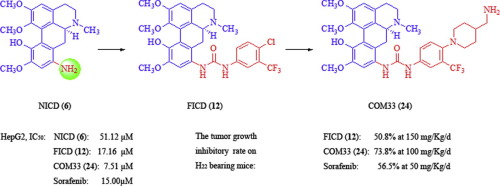Bioorganic & Medicinal Chemistry ( IF 3.5 ) Pub Date : 2017-10-21 , DOI: 10.1016/j.bmc.2017.10.027 Qian Yan , Ruxia Li , Aiyi Xin , Yin Han , Yanxia Zhang , Junxi Liu , Wenguang Li , Duolong Di

|
Isocorydine (ICD), an aporphine alkaloid, is widely distributed in nature. Its ability to target side population (SP) cells found in human hepatocellular carcinoma (HCC) makes it and its derivative 8-amino-isocorydine (NICD) promising chemotherapeutic agents for the treatment of HCC. To improve the anticancer activity of isocorydine derivatives, twenty derivatives of NICD were designed and synthesized through chemical structure modifications of the aromatic amino group at C-8. The anti-proliferative activities of all synthesized compounds against human hepatocellular (HepG2), cervical (HeLa), and gastric (MGC-803) cancer cell lines were evaluated using an MTT assay. The results showed that all the synthetic compounds had some tumor cell growth inhibitory activity. The compound COM33 (24) was the most active with IC50 values under 10 μM (IC50 for HepG2 = 7.51 µM; IC50 for HeLa = 6.32 μM). FICD (12) and COM33 (24) were selected for further investigation of their in vitro and in vivo activities due to their relatively good antiproliferative properties. These two compounds significantly downregulated the expression of four key proteins (C-Myc, β-Catenin, CylinD1, and Ki67) in HepG2 cells. The tumor inhibition rate of COM33 (24) in vivo was 73.8% after a dose 100 mg/kg via intraperitoneal injection and the combined inhibition rate of COM33 (24) (50 mg/kg) with sorafenib (50 mg/kg) was 66.5%. The results indicated that these isocorydine derivatives could potentially be used as targeted chemotherapy agents or could be further developed in combination with conventional chemotherapy drugs to target cancer stem cells (CSCs) and epithelial-to-mesenchymal transition (EMT), the main therapeutic targets in HCC.
中文翻译:

异高碘衍生物的设计,合成和抗癌特性
异鸟苷(ICD),一种阿菲啡生物碱,在自然界中分布广泛。它具有靶向人类肝细胞癌(HCC)中的侧群(SP)细胞的能力,使其及其衍生的8-氨基-异金鱼精(NICD)有望成为治疗HCC的化学治疗剂。为了提高异高碘衍生物的抗癌活性,通过修饰C-8位芳香族氨基的化学结构,设计并合成了20种NICD衍生物。使用MTT分析评估了所有合成化合物对人肝细胞(HepG2),宫颈癌(HeLa)和胃癌(MGC-803)癌细胞的抗增殖活性。结果表明,所有合成化合物均具有一定的抑制肿瘤细胞生长的活性。化合物COM33(24)最活跃,IC 50值低于10μM(HepG2的IC 50 = 7.51μM; HeLa的IC 50 = 6.32μM)。由于FICD(12)和COM33(24)具有相对良好的抗增殖特性,因此被选择用于进一步研究其体外和体内活性。这两种化合物显着下调了HepG2细胞中四种关键蛋白(C-Myc,β-Catenin,CylinD1和Ki67)的表达。COM33的肿瘤抑制率(24)体内的剂量100mg / kg的通过腹膜内注射和COM33的组合抑制率后为73.8%(24)(50 mg / kg)与索拉非尼(50 mg / kg)为66.5%。结果表明,这些异辛基碘衍生物有可能被用作靶向化疗药物,或者可以与常规化疗药物联合开发,以靶向癌症干细胞(CSCs)和上皮向间质转化(EMT),这是该药物的主要治疗靶标。肝癌



























 京公网安备 11010802027423号
京公网安备 11010802027423号